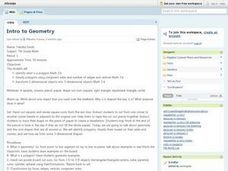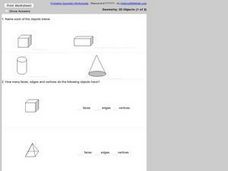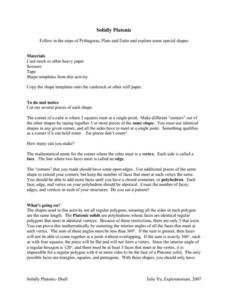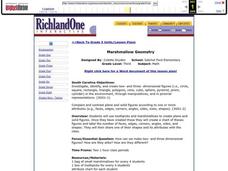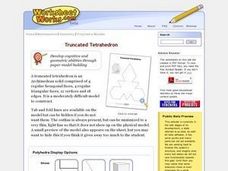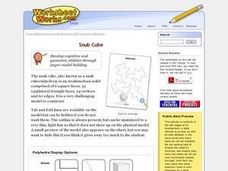Curated OER
Our Tangible World is Full of Dimensions
Sixth graders explore characteristics of two and three-dimensional figures. They observe the teacher demonstrate the faces, edges, vertices and names of specific figures. In groups, 6th graders examine and describe given figures. ...
Curated OER
3-D Attributes
Students explore geometric solids. In this geometry instructional activity, students listen to the book The Greedy Triangle by Marilyn Burns, then work in groups to sort geometric solids into various categories. Students define geometric...
Curated OER
How many edges do I need to cut in order to open a cube?
Students problem solve to open a cube to create different shapes. In this problem solving lesson plan, students are given a cube and the shapes to open it up to, and they have to cut the cube open to make certain shapes. This gives them...
Curated OER
Geometry Assessment: Solid Figures
In this geometry assessment worksheet, students match the drawing of two faces of the solid to the name of the solid for six geometric figures.
Curated OER
Three-Dimensional Figures
Sixth graders explore three-dimensional objects. In groups, they create and decorate their own polyhedron design. After identifying the faces, vertices, and edges of the polyhedron, 6th graders determine a relationship between the...
Curated OER
Tetrahedron Kites
Let's go fly a kite! Discuss the concept of two-dimensional and three-dimensional objects with your math class. They examine a triangle and discuss the face, vertices, edges, and angles. Then they build their own Tetrahedral Kites and...
Annenberg Foundation
Geometry 3D Shapes: Platonic Solids
From polyhedrons to platonic solids, here is a lesson that will have your classes talking! As an introduction to platonic solids, scholars cut and fold nets to create the three-dimensional solids. They use an interactive component to...
Oleh Yudin
iCrosss
Did you know that a soccer ball is very similar to a truncated icosahedron? Both have 32 faces, but while a truncated icosahedron is made up solely of flat hexagons, a traditional soccer ball has 12 pentagons and 20 hexagons, each curved...
Curated OER
Intro to Geometry
Seventh graders identify a polygon and classify them using congruent sides and number of edges and vertices. Students transform two dimensional objects into three dimensional objects.
Curated OER
Geometry: 3D Objects
In this math worksheet, learners examine 4 pictures of 3D objects and write the name of each. Students then study 3 pictures and figure the number of faces, edges and vertices on each.
Curated OER
Toothpicks, Gumdrops, and Polyhedrons
Sixth graders use toothpicks and gumdrops to make prisms and pyramids. This helps them explore the relationship betweeen faces, vertices, and edges.
Curated OER
Edible Geometry
Young scholars examine a chart that lists the main characteristics of polygons and 3 dimensional figures. They make examples of the polygons and figures using pretzels and gum drops showing how the gum drops are vertices and the pretzels...
Curated OER
Euler's Theorem
In this Euler's Theorem worksheet, 10th graders solve and complete 15 various types of problems. First, they find the distance and midpoint of a segment given its endpoints. Then, students identify the number of vertices, edges, and...
Curated OER
Third Grade Geometry
Third graders describe 2D and 3D shapes. In this geometry instructional activity, 3rd graders watch a PowerPoint presentation showing the terms used when analyzing shapes: vertex, edge, angle, side, and face. They compare shapes to see...
Curated OER
Solidly Platonic
When they do, they learn. Using this resource, young mathematicians learn about platonic solids by actually building, touching, and examining the shapes. They connect their observations about the shapes to Euler's formula.
Curated OER
Visualize 3-D Objects and Make Nets of Common Solids
In this 3-D objects and common solids worksheet, students cut out and count the number of faces on several different types of boxes and make a cuboid from straws or a card. Students fill out 4 different categories involving 5 different...
Curated OER
Marshmallow Geometry
Third graders create 2D and 3D shapes using marshmallows and toothpicks. In this geometry lesson, 3rd graders create their shapes and document the number of faces, edges, corners, angles, and sides. They share one shape and its...
Curated OER
Octahedron
In this math worksheet, learners develop cognitive and geometric abilities. They construct a paper model of a octahedron composed of eight triangular faces, six vertices and 12 edges.
Curated OER
Polygons Defined
Fourth graders explore polygons. In this polygon activity, 4th graders sort polygons according to their properties. Students discover the connection between polygons and the Greek language.
Curated OER
Pyramids & Prisms: Guler's Formula
Sixth graders compare and contrast two-dimensional shapes to three-dimensional shapes. After watching a demonstration, they make their own shapes using nets printed on paper. To end the instructional activity, they use the shapes they...
Curated OER
Three-Dimensional Play Dough
Fourth graders make models of three-dimensional figures and then use these play dough figures to observe and count the vertices, edges, and faces of the figure.
Curated OER
Truncated Tetrahedron
In this math worksheet, middle schoolers read about the truncated tetrahedron and then create a paper model. It should look like a solid comprised of 4 regular hexagonal faces, 4 regular triangular. faces, 12 vertices and 18 edges.
Curated OER
Snub Cube
In this math worksheet, students create a paper model of a snub cube. It is an Archimedean solid comprised of 6 square faces, 32 equilateral triangle faces, 24 vertices and 60 edges.
Curated OER
Tetrahedron
In this math worksheet, students construct a paper model of a tetrahedron. They create it to have four triangle faces, four vertices and six edges.
Other popular searches
- Faces Vertices Edges
- Faces, Vertices, Edges
- Prism Faces Edges Vertices
- Faces, Vertices, and Edges
- Edges, Faces, and Vertices
- Edges, Faces, Vertices
- Faces Vertices and Edges
- Faces, Edges, Vertices's
- Faces Edges Vertices's
- Edges, Faces , Vertices
- Faces, Vertices and Edges
- Vertices and Edges and Faces










